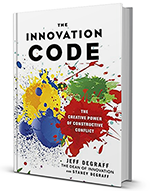When it comes to thinking creatively, people’s abilities always have room
Is everyone creative? Sure they are, but in very different ways and to varying degrees. Our democratic longing to make everyone and everything equal has led us to make creative greatness indistinguishable from an act of personal expression. What is lacking is meaningful appreciation of the different levels of creativity and how we can use them as steps for increasing our own creative potential.
Below are the five levels and types of creativity, from the easiest to the most difficult to master, along with suggestions for building creative muscle:
Mimetic Creativity:
Mimesis is a term passed down to us from the Ancient Greeks meaning to imitate or mimic. This is the most rudimentary form of creativity. To improve mimetic creativity, travel to new places and meet new people. Be sure to look for patterns and benchmarks, as well as indicators of success or failure so that you have good ideas about what really works and what doesn’t and why.
Biosociative Creativity:
Analogical Creativity:
Analogical creativity uses analogies to transfer information that we believe we understand in one domain, the source, to help resolve a challenge in an unfamiliar area, the target. In essence, analogies are bridges that allow our cognitive processes to quickly transport clusters of information from the unknown to the known, and back again. Analogies can also be used to disrupt habit-bound thinking to make way for new ideas. You can develop your analogical creativity through the “imaginary friend” role storming method whereby you imagine what someone might say or do if faced with a particular challenge.
Narratological Creativity:
At its essence, narratological creativity is the art of storytelling. Our personal stories are perhaps the ultimate use of narratological creativity as we invent and reinvent the story of our life. In this way something that is deeply personal becomes allegorical or of mythic significance. You can improve your narratological creativity by practicing the art of storyboarding or by engaging in scenario making to project potential courses of action.
Intuitive Creativity:
This final and most challenging level of creativity has often been promoted to the realm of spiritual and wisdom traditions. This is where creativity becomes bigger and possibly beyond us; it transcends our individuality. There are several methods for freeing and emptying the mind – meditation, yoga and chanting to name a few. The basic idea is to distract and relax the mind to create a flow state of consciousness where ideas come easily. The approaches to developing intuitive creativity are too numerous to chronicle here; however, free writing is straightforward way to connect us with our intuitive self by simply observing what flows out of the pen or the tapping of the keys.
As with any learned ability, you have to practice. Even creative geniuses practice all the time. The following article from Fortune Magazine is a good place to find out more. Check out this video below about the five levels of creativity may also be helpful.
Originally published on Quora.

Unleash your creativity
Discover the power of constructive conflict and how it can help foster innovation. By reading The Innovation Code, you will learn how to harness tension and transform it into positive energy to successfully implement your innovation projects.
